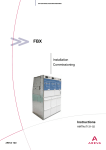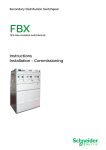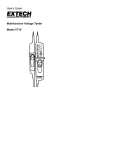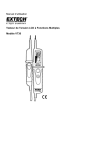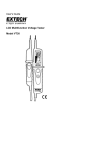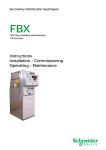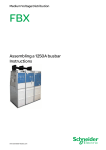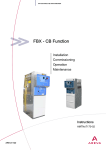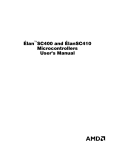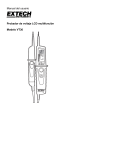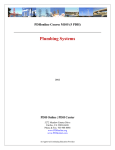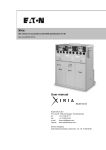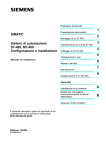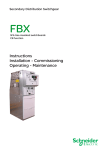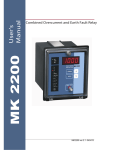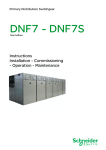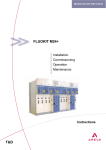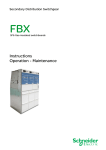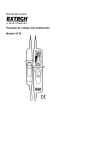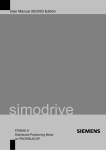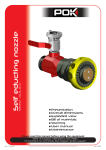Download FBX - Schneider Electric
Transcript
Secondary Distribution Switchgear FBX SF6 Gas-insulated switchboards Instructions Installation - Commissioning FBX Contents 1 Schneider Electric at your service . . . . . . . . . . . . . . . . . . . 1 1.1 1.2 Our Service Unit: our specialists, and suitably adapted services... . . . . . . . . . Schneider Electric Training: Together, let us develop our skills... . . . . . . . . . . . 1 1 2 With regards to this User Manual . . . . . . . . . . . . . . . . . . . . 2 2.1 2.2 2 2.6 2.7 Responsibilities . . . . . . . . . . . . . . . . . . . . . . . . . . . . . . . . . . . . . . . . . . . . . . . . . . . Reminder concerning normal service conditions (in accordance with IEC60694) . . . . . . . . . . . . . . . . . . . . . . . . . . . . . . . . . . . . . . * Permissible ambient temperature . . . . . . . . . . . . . . . . . . . . . . . . . . . . . . . . . . . * Installation altitude . . . . . . . . . . . . . . . . . . . . . . . . . . . . . . . . . . . . . . . . . . . . . . . . * Atmospheric pollution . . . . . . . . . . . . . . . . . . . . . . . . . . . . . . . . . . . . . . . . . . . . . * Permissible atmospheric humidity level . . . . . . . . . . . . . . . . . . . . . . . . . . . . . . Particular instructions for operations and interventions on energized equipment . . . . . . . . . . . . . . . . . . . . . . . . . . . . . . . . . . . . . . . . . . . . Other technical notices to be consulted . . . . . . . . . . . . . . . . . . . . . . . . . . . . . . . . Tools and products (not supplied) required for the operations described in this notice . . . . . . . . . . . . . . . . . . . . . . . . . . . . . . . . . . . . . . . . . . . . . . . . . . . . . . . . . . . . Symbols & conventions . . . . . . . . . . . . . . . . . . . . . . . . . . . . . . . . . . . . . . . . . . . . . Tightening torque values [Nm] for standard assemblies (nut + bolt) . . . . . . . . . 3 Presentation . . . . . . . . . . . . . . . . . . . . . . . . . . . . . . . . . . . . . . . 4 3.1 3.2 3.3 3.4 3.5 3.6 3.7 4 5 6 7 8 9 3.8 Identification of the FBX . . . . . . . . . . . . . . . . . . . . . . . . . . . . . . . . . . . . . . . . . . . . Presentation of the FBX-C (non-extendable model) . . . . . . . . . . . . . . . . . . . . . . Presentation of the FBX-E (extendable model) . . . . . . . . . . . . . . . . . . . . . . . . . Presentation of “Measurement” functions . . . . . . . . . . . . . . . . . . . . . . . . . . . . . . Presentation of mimic diagrams for manual controls . . . . . . . . . . . . . . . . . . . . . Presentation of mimic diagrams for motorised controls (See legend § 3.5) . . . Presentation of the mimic diagrams used on 'Measurement' functions (See legend § 3.5) . . . . . . . . . . . . . . . . . . . . . . . . . . . . . . . . . . . . . . . . . . . . . . . . . Presentation of the mimic diagram on the 'Sb' function (See legend § 3.5) . . . 4 Storage - Packing . . . . . . . . . . . . . . . . . . . . . . . . . . . . . . . . . . 10 4.1 4.2 4.3 FBX switchboard packing . . . . . . . . . . . . . . . . . . . . . . . . . . . . . . . . . . . . . . . . . . . Specific transportation requirements . . . . . . . . . . . . . . . . . . . . . . . . . . . . . . . . . . Temporary storage – less than 6 months . . . . . . . . . . . . . . . . . . . . . . . . . . . . . . 10 10 10 5 Handling and Unpacking . . . . . . . . . . . . . . . . . . . . . . . . . . . . 11 5.1 5.2 5.3 5.4 Reminder . . . . . . . . . . . . . . . . . . . . . . . . . . . . . . . . . . . . . . . . . . . . . . . . . . . . . . . . Unpacking . . . . . . . . . . . . . . . . . . . . . . . . . . . . . . . . . . . . . . . . . . . . . . . . . . . . . . . . Valorizing packaging waste . . . . . . . . . . . . . . . . . . . . . . . . . . . . . . . . . . . . . . . . . Delivery cable blanking plate (option) . . . . . . . . . . . . . . . . . . . . . . . . . . . . . . . . . Handling . . . . . . . . . . . . . . . . . . . . . . . . . . . . . . . . . . . . . . . . . . . . . . . . . . . . . . . . . Packing . . . . . . . . . . . . . . . . . . . . . . . . . . . . . . . . . . . . . . . . . . . . . . . . . . . . . . . . . . 11 11 11 11 11 11 6 Fixing to the floor . . . . . . . . . . . . . . . . . . . . . . . . . . . . . . . . . . 12 6.1 6.2 Opening the cable compartment cover . . . . . . . . . . . . . . . . . . . . . . . . . . . . . . . . Fixing to the floor . . . . . . . . . . . . . . . . . . . . . . . . . . . . . . . . . . . . . . . . . . . . . . . . . . 12 12 7 Earthing the FBX switchboard . . . . . . . . . . . . . . . . . . . . . . . 13 7.1 7.2 Location of the connector terminal . . . . . . . . . . . . . . . . . . . . . . . . . . . . . . . . . . . . Connecting the earthing cable . . . . . . . . . . . . . . . . . . . . . . . . . . . . . . . . . . . . . . . 13 13 8 Connection of the HV cables . . . . . . . . . . . . . . . . . . . . . . . . 14 8.1 8.2 Standard equipment for the FBX – up to 24 kV . . . . . . . . . . . . . . . . . . . . . . . . . . Connection adapter cones for cross-members in accordance with NF-EN50181 . . . . . . . . . . . . . . . . . . . . . . . . . . . . . . . . . . . . . . . . . . . . . . . . . Connection of the cables . . . . . . . . . . . . . . . . . . . . . . . . . . . . . . . . . . . . . . . . . . . . General connection precautions . . . . . . . . . . . . . . . . . . . . . . . . . . . . . . . . . . . . . . Type A connection . . . . . . . . . . . . . . . . . . . . . . . . . . . . . . . . . . . . . . . . . . . . . . . . . Type C connection . . . . . . . . . . . . . . . . . . . . . . . . . . . . . . . . . . . . . . . . . . . . . . . . . Attaching the cables and connecting the earthing braids . . . . . . . . . . . . . . . . . Clip-fit clamps . . . . . . . . . . . . . . . . . . . . . . . . . . . . . . . . . . . . . . . . . . . . . . . . . . . . . Screw-fit clamps . . . . . . . . . . . . . . . . . . . . . . . . . . . . . . . . . . . . . . . . . . . . . . . . . . Fitting of cables with a blanking-off flooring (optional) . . . . . . . . . . . . . . . . . . . . Assembly of 3 cables per phase (optional) . . . . . . . . . . . . . . . . . . . . . . . . . . . . . Access to the connections for the 25 kA cables (optional) . . . . . . . . . . . . . . . . Fitting one or two cores per phase (option) . . . . . . . . . . . . . . . . . . . . . . . . . . . . . 14 2.3 2.4 2.5 8.3 8.4 8.5 8.6 8.7 8.8 8.9 8.10 8.11 AMTNoT131-02 revision: 10 2 2 2 2 2 2 3 3 3 3 9 9 14 14 14 14 15 15 15 16 17 18 19 19 i FBX 9 Switchboard extensions (FBX-E series) . . . . . . . . . . . . . . 20 9.1 9.2 9.3 9.4 9.5 9.6 Intervention levels . . . . . . . . . . . . . . . . . . . . . . . . . . . . . . . . . . . . . . . . . . . . . . . . . Intervention Instructions . . . . . . . . . . . . . . . . . . . . . . . . . . . . . . . . . . . . . . . . . . . . FBX switchboard lockout . . . . . . . . . . . . . . . . . . . . . . . . . . . . . . . . . . . . . . . . . . . Connecting a 1250 A busbar . . . . . . . . . . . . . . . . . . . . . . . . . . . . . . . . . . . . . . . . Reminder on the use of blanking plugs . . . . . . . . . . . . . . . . . . . . . . . . . . . . . . . . Coupling accessories . . . . . . . . . . . . . . . . . . . . . . . . . . . . . . . . . . . . . . . . . . . . . . A box, containing: . . . . . . . . . . . . . . . . . . . . . . . . . . . . . . . . . . . . . . . . . . . . . . . . . Additional supplies . . . . . . . . . . . . . . . . . . . . . . . . . . . . . . . . . . . . . . . . . . . . . . . . . Equipment for the Functional Unit extension (See § 9.6) . . . . . . . . . . . . . . . . . . Extendable switchboard equipment (See § 9.6) . . . . . . . . . . . . . . . . . . . . . . . . . Preparation the existing extensible unit (Version after 03/2008) . . . . . . . . . . . . Preparation and installation of the insulated extension connectors (5) . . . . . . Installation of the insulated extension connectors (5) . . . . . . . . . . . . . . . . . . . . Preparation the existing extensible unit (Version before 04/2008) . . . . . . . . . . Preparation of the extension unit . . . . . . . . . . . . . . . . . . . . . . . . . . . . . . . . . . . . . Switchboard assembly . . . . . . . . . . . . . . . . . . . . . . . . . . . . . . . . . . . . . . . . . . . . . Fixing to the floor and connecting . . . . . . . . . . . . . . . . . . . . . . . . . . . . . . . . . . . . 20 20 20 20 20 21 21 21 21 22 23 24 24 24 25 25 26 10 Fitting a protective cover (Function M Only) . . . . . . . . . . 27 10.1 10.2 For a LHS coupling . . . . . . . . . . . . . . . . . . . . . . . . . . . . . . . . . . . . . . . . . . . . . . . . RHS coupling . . . . . . . . . . . . . . . . . . . . . . . . . . . . . . . . . . . . . . . . . . . . . . . . . . . . . 27 27 11 Fitting a rear deflector to a Function M . . . . . . . . . . . . . . . 28 11.1 11.2 When required . . . . . . . . . . . . . . . . . . . . . . . . . . . . . . . . . . . . . . . . . . . . . . . . . . . . Fitting the deflector to the rear of the Function M . . . . . . . . . . . . . . . . . . . . . . . . 28 28 12 Connecting transformers within Measurement Functional Units . . . . . . . . . . . . . . . . . . . . . . . . . . . . . . . . . . . . . . . . . . . . . . 29 12.1 12.2 12.3 General . . . . . . . . . . . . . . . . . . . . . . . . . . . . . . . . . . . . . . . . . . . . . . . . . . . . . . . . . . Connecting transformers in a type M2 or M3 functional unit . . . . . . . . . . . . . . . Connecting transformers in a Type M4 fonctional unit . . . . . . . . . . . . . . . . . . . . 29 29 29 13 Low Voltage Connections . . . . . . . . . . . . . . . . . . . . . . . . . . . 30 13.1 13.2 Intervention conditions (see § 9.1) . . . . . . . . . . . . . . . . . . . . . . . . . . . . . . . . . . . . Connection of the low voltage wiring . . . . . . . . . . . . . . . . . . . . . . . . . . . . . . . . . . Refit the panels . . . . . . . . . . . . . . . . . . . . . . . . . . . . . . . . . . . . . . . . . . . . . . . . . . . Other possible connections . . . . . . . . . . . . . . . . . . . . . . . . . . . . . . . . . . . . . . . . . Circuit diagrams . . . . . . . . . . . . . . . . . . . . . . . . . . . . . . . . . . . . . . . . . . . . . . . . . . . Switch position contacts [-Q11] . . . . . . . . . . . . . . . . . . . . . . . . . . . . . . . . . . . . . . Earthing switch position contacts [-Q81] . . . . . . . . . . . . . . . . . . . . . . . . . . . . . . . Standard diagram for motorised control (type AB2 - alternating current) for Function C . . . . . . . . . . . . . . . . . . . . . . . . . . . . . . . . . . . . . . . . . . . . . . . . . . . . . Standard diagram for motorised control (type AB3) for Function C . . . . . . . . . Standard diagram for motorised control (type AB2) for Function T1 . . . . . . . . . Standard diagram of a WIC1 protection (type AB3) for Function T2 . . . . . . . . . “Measure - protection - signalling” part . . . . . . . . . . . . . . . . . . . . . . . . . . . . . . . . “Control” part . . . . . . . . . . . . . . . . . . . . . . . . . . . . . . . . . . . . . . . . . . . . . . . . . . . . . 30 30 30 31 31 31 31 32 33 34 35 35 36 14 Fitting the HV fuses . . . . . . . . . . . . . . . . . . . . . . . . . . . . . . . . . 37 14.1 14.6 Dimensions (mm) of the fuses – in accordance with standards IEC60282-1 and IEC62271-105 . . . . . . . . . . . . . . . . . . . . . . . . . . . . . . . . . . . . . . . . . . . . . . . . . Fitting of an adapter for fuses of upto 12 kV . . . . . . . . . . . . . . . . . . . . . . . . . . . . Selection table for Schneider Electric fuses (FDwT) with integrated strikers (for Function T1) . . . . . . . . . . . . . . . . . . . . . . . . . . . . . . . . . . . . . . . . . . . . . . . . . . SIBA fuse selection table . . . . . . . . . . . . . . . . . . . . . . . . . . . . . . . . . . . . . . . . . . . Fitting a fuse . . . . . . . . . . . . . . . . . . . . . . . . . . . . . . . . . . . . . . . . . . . . . . . . . . . . . . Open the access cover to the standard fuse holders . . . . . . . . . . . . . . . . . . . . . Opening of the access cover to the leaktight fuse holders (by key or handle) Fitting the fuses in place . . . . . . . . . . . . . . . . . . . . . . . . . . . . . . . . . . . . . . . . . . . . Mechanical trip test on blown fuse . . . . . . . . . . . . . . . . . . . . . . . . . . . . . . . . . . . . 15 Protection Relays WIC1 or DPX-1 . . . . . . . . . . . . . . . . . . . . 40 15.1 15.2 15.3 15.4 Location of the protection relays . . . . . . . . . . . . . . . . . . . . . . . . . . . . . . . . . . . . . Access to the relays of a single T2 function (See markings in § 15.1) . . . . . . . Setting of the protection relays . . . . . . . . . . . . . . . . . . . . . . . . . . . . . . . . . . . . . . . The protection relays WIC1 & DPX-1 . . . . . . . . . . . . . . . . . . . . . . . . . . . . . . . . . 40 40 40 41 9.7 9.8 9.9 13.3 13.4 13.5 13.6 13.7 13.8 13.9 14.2 14.3 14.4 14.5 ii 37 37 37 38 38 38 38 39 39 AMTNoT131-02 revision: 10 FBX Contents 15.5 Fault indicator WI1-SZ5 . . . . . . . . . . . . . . . . . . . . . . . . . . . . . . . . . . . . . . . . . . . . . 41 16 Commissioning . . . . . . . . . . . . . . . . . . . . . . . . . . . . . . . . . . . . 42 16.1 16.2 16.3 16.4 16.5 16.6 16.8 16.9 Reminder . . . . . . . . . . . . . . . . . . . . . . . . . . . . . . . . . . . . . . . . . . . . . . . . . . . . . . . . Carry out an inventory of all tools and accessories on completion of the work Pre-commissioning information . . . . . . . . . . . . . . . . . . . . . . . . . . . . . . . . . . . . . . Principle pre-commissioning checks . . . . . . . . . . . . . . . . . . . . . . . . . . . . . . . . . . Energizing the FBX switchboard . . . . . . . . . . . . . . . . . . . . . . . . . . . . . . . . . . . . . VDS – Voltage Detection Systems . . . . . . . . . . . . . . . . . . . . . . . . . . . . . . . . . . . . HR System (High Resistance) . . . . . . . . . . . . . . . . . . . . . . . . . . . . . . . . . . . . . . . IVIS (Intelligent Voltage Information System) . . . . . . . . . . . . . . . . . . . . . . . . . . . Verification of phase concordance (for IVIS) . . . . . . . . . . . . . . . . . . . . . . . . . . . . Capdis KRIES . . . . . . . . . . . . . . . . . . . . . . . . . . . . . . . . . . . . . . . . . . . . . . . . . . . . VPIS (Voltage Present Indicating System) . . . . . . . . . . . . . . . . . . . . . . . . . . . . . Voltage Present Indications verifications with a standard unit . . . . . . . . . . . . . . Voltage Present Indications verifications with a Kries unit . . . . . . . . . . . . . . . . . Starting up the switchboard . . . . . . . . . . . . . . . . . . . . . . . . . . . . . . . . . . . . . . . . . . Short-circuit indicators (optional) . . . . . . . . . . . . . . . . . . . . . . . . . . . . . . . . . . . . . 42 42 42 42 42 42 42 43 43 44 44 44 45 45 45 17 Notes . . . . . . . . . . . . . . . . . . . . . . . . . . . . . . . . . . . . . . . . . . . . . . 46 16.7 AMTNoT131-02 revision: 10 iii FBX 1 Schneider Electric at your service Operations and maintenance may only be carried out by personnel who have received suitable authorisation for the operations and manœuvres they are responsible for performing. If this is not the case, please refer to our Service Unit or Training Centre. 1.1 All locking-out operations must be performed according to the ”General Safety Instructions booklet for Electrical Applications” UTE C 18 510 (or its equivalent outside FRANCE). Our Service Unit: our specialists, and suitably adapted services... Guarantee extension contracts in relation to the selling of new equipment, Supervision of HVA switchgear installations, Technical advice, diagnoses of the facilities, expertise, Maintenance contracts adapted to operational constraints, Systematic or conditional preventive maintenance, Corrective maintenance in case of partial or complete failure, Supply of spare parts, Overhauling of equipment and requalification of installations in order to benefit from new technologies and extend the life of your switchgear by limited investments. J J J J J J J J Contact the Schneider Electric Service Unit for diagnoses and advice: Working hours ) 33 (0)3 85 29 35 00 33 (0)3 85 29 36 30 or 33 (0)3 85 29 36 43 1.2 Schneider Electric Training: Together, let us develop our skills... We can place at your disposal all of our trainers' expertise, our teams' pedagogical experience and the wealth of our equipment, to help you face the challenge of encouraging the personal development of each individual through the optimisation of their skills. From a few hours up to several weeks, Schneider Electric Training has the control over all of the teaching processes in order to meet the needs of each customer. J J J J Specific training, directly operational with practical work on real machines. Small groups to facilitate communication. Balance between theory and practice. Evaluation and management of the skills: Measurement and optimisation of the trainees' knowledge. Faced with the direct and indirect training costs of the operational stoppages and shutdown, training is a real investment Schneider Electric France Training Centre 35 rue Joseph Monier - CS 30323 - F-92506 Rueil-Malmaison Cedex www.schneider-electric.fr/formation AMTNoT131-02 revision: 10 1 FBX 2 With regards to this User Manual © - Schneider Electric - 2010. Schneider Electric, the Schneider Electric logo and their figurative forms are Schneider Electric registered trademarks. The other brand names mentioned within this document, whether they be copyright or not, belong to their respective holders. 2.1 Responsibilities Our devices are quality controlled and tested at the factory in accordance with the standards and the regulations currently in force. Apparatus efficiency and apparatus life depend on the compliance with the installation, commissioning and operation instructions described in this user manual. Non respect of these instructions is likely to invalidate any guarantee. Local requirements especially about safety and which are in accordance with the indications given in this document, must be observed. 2.2 Schneider Electric declines any responsibility for the consequences: - due to the non respect of the recommendations in this manual which make reference to the international regulations in force. - due to the non respect of the instructions by the suppliers of cables and connection accessories during installation and fitting operations, - of any possible aggressive climatic conditions (humidity, pollution, etc.) acting in the immediate environment of the materials that are neither suitably adapted nor protected for these effects. This user manual does not list the locking-out procedures that must be applied. The interventions described are carried out on de-energized equipment (in the course of being installed) or locked out (non operational). Reminder concerning normal service conditions (in accordance with IEC60694) * Permissible ambient temperature The ambient air temperature should be comprised between - 15°C and + 40° C. The mean measured value for a 24 hour period must not exceed 35°C. * Installation altitude HV equipment is defined in accordance with European Standards and can be used up to an altitude of 1,000 m. Beyond this, account must be taken of the decrease in dielectric withstand. For these specific cases, contact the Schneider Electric Sales Department. * Atmospheric pollution The ambient air must not contain any dust particles, fumes or smoke, corrosive or flammable gases, vapours or salts. * Permissible atmospheric humidity level The average atmospheric relative humidity level measured over a 24-hour period must not exceed 95%. The average water vapour pressure over a period of 24 hours must not exceed 22 mbar. The average atmospheric relative humidity value measured over a period of one month must not exceed 90 %. The average water vapour pressure over a period of one month must not exceed 18 mbar. 2.3 Whenever the humidity level is higher than 95 %, we recommend that you take appropriate corrective measures. For any assistance or advice, contact the Schneider Electric After-Sales department (See § 1.1). Particular instructions for operations and interventions on energized equipment When commissioning and operating the equipment under normal conditions, the General safety instructions for electrical applications must be respected, (protective gloves, insulating stool, etc.), in addition to standard operating instructions. 2 Condensation may appear in case of any sharp variation in temperature, due to excessive ventilation, a high atmospheric humidity level or the presence of hot air. This condensation can be avoided by an appropriate lay-out of the room or of the building (suitably adapted ventilation, air driers, heating etc.). All manipulations must be completed once started. The durations (for completing the operations mentioned) given in the maintenance tables are purely an indication and depend on on-site conditions. AMTNoT131-02 revision: 10 FBX 2.4 J J J J J J J J J J Other technical notices to be consulted AMTNoT110-02 AMTNoT132-02 AMTNoT137-02 AMTNoT140-02 AMTNoT150-02 AMTNoT153-02 AMTNoT161-02 AMTNoT164-02 AGS531751-01 AGS531753-01 2.5 FBX FBX FBX FBX FBX FBX DPX-1 FBX-E IVIS and IVIS-F MS100 Guide to Civil Engineering Work Operations - Maintenance Handling - Storage Motor-controlled mechanical commands Assembly on an internal arc channel Mechanical key-type interlocking Assembly-operation Self Powered Relay Handling of Coupled Functional Units Voltage Detection Systems Phase Comparator Tools and products (not supplied) required for the operations described in this notice - Crowbar - Scissors - Open-ended spanners sizes 7, 13 and 17 - 2 x open-ended spanner - size 16 - Ratchet handle + extension with socket sizes 8, 10, 13 and 16 mm - Torque wrench 2.6 Symbols & conventions 06 - Code for a product recommended and marketed by Schneider Electric CAUTION! Remain vigilant! Precautions to be taken in ATTENTION order to avoid accidents or injury 21 Nm - Tightening torque value Example: 21 Nm FORBIDDEN! Do not do it! Compliance with this indication is compulsory, non compliance with this stipulation may damage the equipment. 10 - Mark corresponding to a key INFORMATION - ADVICE Your attention is drawn to a specific point or operation. 2.7 Tightening torque values [Nm] for standard assemblies (nut + bolt) Diameter Plastic (PA 6.6) Steel Class < 8.8 Steel Class > 8.8 < 10.9 Threaded fasteners with grease A2-70 M6 0.8 4.3 8.8 6.6 M8 1.8 10.5 21.0 15.8 M 10 3.5 14.0 42.0 35.0 M 12 6.0 - 70.0 60.0 M 16 12.0 - 170.0 134.0 AMTNoT131-02 revision: 10 3 FBX 3 Presentation This manual covers FBX-C and FBX-E switchboards for 12, 17,5 and 24 kV networks. 3.1 Identification of the FBX The technical data ranges give the individual characteristics of the switchboard. FBX-C / 24-16 / C-C-T1 Switchboard Type : C = Compact E = Extendable Rated voltage 24kV Short circuit current rated 16kA Functions making up the switchboard C = Load-break switch T1 = Combinated or associated fuse and load-break switch T2 = Transformer protection circuit breaker R = Direct linkage RE = Direct incoming feeder with earthing switch M1 = Measurement with cable connections M2 = Measurement - for RHS extension M3 = Measurement - for LHS extension M4 = Measurement - for extension (Left or Right) Sb = Busbar disconnector 4 AMTNoT131-02 revision: 10 FBX 3.2 Presentation of the FBX-C (non-extendable model) 10 9 1 2 3 11 4 5 6 7 0 Legend - 1 - 2 Voltage presence indicator light and low voltage compartment panel Mimic diagram panel - 3 4 5 Fuse compartment End plug Fuse compartment access panel - 6 7 Cable compartment cover HVA connections - 8 9 10 - 11 8 Adjustable cable mounts Lifting ring Removable top panel - low voltage connections Technical data rating plate AMTNoT131-02 revision: 10 5 FBX 3.3 Presentation of the FBX-E (extendable model) 3 2 5 6 7 4 10 8 1 9 0 6 Legend - 1 2 3 Functional Unit - Extension Bus bar connector Functional Unit - Top Coupling - 4 5 6 - 7 Functional Unir coupling Points Mimic diagram panel Voltage presence indicator light and low voltage compartment panel Extension system access panel - 8 9 10 Blanking panel Cable compartment cover Technical data and rating plates AMTNoT131-02 revision: 10 FBX 3.4 Presentation of “Measurement” functions Function M1 Cable connection 1 3 Function M2 RHS Extension 4 5 6 7 2 Function M3 LHS Extension 0 Legend - 1 2 3 Technical data rating plate Bolted panel Bus bar connector - 4 5 6 Bushing Current transformer Voltage transformer - 7 HVA connections Function M4 Right or left hand side extension AMTNoT131-02 revision: 10 7 FBX 3.5 Presentation of mimic diagrams for manual controls 23 Extendable 8 1 5 2 6 Not extendable 8 2 7 1 5 2 9 3 3 4 4 Function C “Extendable” Function T1 “Non extendable RHS” Not extendable 0 1 2 3 4 Function RE “Non-extendable LHS” 23 10 24 11 12 13 16 1 15 2 14 Legend - 1 2 3 Lever socket for the earthing switch Earthing switch position indicator Cable compartment cover latch - 4 5 6 Descriptive plate Load-break switch position indicator Lever socket for the load-break switch - 7 8 9 Lever socket for the load-break switch Load-break switch or disconnector locking latch Fuse blown indicator - 10 11 12 Circuit breaker position indicator (O and I) Lever socket for the circuit breaker Circuit breaker locking latch - 13 14 15 Fault Trip indicator Disconnector locking latch Disconnector position indicator - 16 17 Lever socket for the disconnector Technical data rating plate - 18 19 20 Voltage transformers Current transformers Cable connections - 21 22 Busbar connections Location of the backup handle (load-break switch or circuit breaker) - 23 24 Operations counter (optional) Tripping push button (optional) 3 Function T2 8 AMTNoT131-02 revision: 10 FBX 3.6 Presentation of mimic diagrams for motorised controls (See legend § 3.5) 22 22 22 J Function C 'Motorised': Socket to insert the emergency manual load-break switch operating handle. 3.7 J Function T1 'Motorised': Socket to insert the emergency manual load-break switch operating handle. J Function T2 'Motorised': Socket to insert the emergency manual control for the circuit-breaker. Presentation of the mimic diagrams used on 'Measurement' functions (See legend § 3.5) Function M3 Function M1 21 18 18 19 19 17 17 20 20 Function M2 21 Function M4 21 21 18 18 19 17 3.8 20 19 17 Presentation of the mimic diagram on the 'Sb' function (See legend § 3.5) 21 8 21 2 6 1 5 22 AMTNoT131-02 revision: 10 9 FBX 4.1 4 Storage - Packing FBX switchboard packing ÁÁÁÁÁÁÁÁ ËË ËËË ËË ËË ËËË ËËËËË ÁÁÁÁÁÁÁÁ ËË ËËËËË ËË ËËË ËË ËË ËËË ËË ËËË ËË ËË ËËË ËË ÁÁÁÁÁÁÁÁ ËËË ËË ËË ËËË ËËËËË ËË ËËËËË ËË ËËË ËË ËË ËËË ÁÁÁÁÁÁÁÁ ËË ËËË ËË ËË ËËË ËËËËË ËË ËËËËË Instructions for handling and unpacking J For road and rail transport: - attached to the pallet using two plastic ribbon strips, - covered by a protective plastic film. 4.2 The packaging of a Functional Unit for air and maritime transport: - under a heat-sealed cover with bags of desiccant, - packed in wooden crates. 2 J 2 1 2 Status of the equipment on delivery: 1. load-break switches, disconnectors and circuit breakers all `open', 2. Earthing switch `closed'. Specific transportation requirements Ensure the FBX switchboard cannot slide or tip. If necessary, nail or chock the transport pallet in place on the truckbed. 4.3 J 1 1 Leave the FBX switchboard in its original packing until it arrives on-site ready for installation. Respect the instructions given on the sheet attached to the front panel of the switchboard. Temporary storage – less than 6 months ÎÎÎÎÎ ÎÎÎÎÎ ÎÎÎÎÎ When the switchboard is not installed on delivery it can be stored for a period not exceeding 6 months under the following conditions: . Preserve the equipment in its original factory packaging. . Any parts unpacked for testing should then be repacked in their original packing. . The site chosen for storage must be capable of protecting the material against possible damage due to: water, water vapour, saline atmospheres, all types of pollution, micro-organisms. + 50° C Contact Schneider Electric for any derogations to these criteria or for storage durations of greater than 6 months 10 - 25° C AMTNoT131-02 revision: 10 FBX 5.1 5 Handling and Unpacking Reminder The FBX switchboard must remain on its pallet, within its original packaging during any eventual storage period and until it arrives at the location of its install‐ ation. 5.2 Unpacking Proceed with unpacking the Functional Units only where they are to be installed on site. Tools required: - Cutter for road and rail transport packaging - Crowbar for air and sea transport packaging Use suitable protective gloves for any hand‐ ling operation. Valorizing packaging waste After unpacking, the materials remaining (cover, wooden floor panel, etc) should be sorted and sent to the appropriate recycling services. Delivery cable blanking plate (option) This plate is not fitted into the switchboard. It is delivered upside down, wedged in place between the transport pallet and the switchboard. See § 8.8 for installation. 5.3 Handling After unpacking, the switchboard must be handled in accordance with the requirements laid out in AMTNoT137-02. The latter document must, systematically, be attached visibly to the FBX itself. 5.4 Packing The standard pack includes the installation, user and maintenance manuals and the operating handles. Other accessories may be included depending on the configuration of the switchboard itself (fuses, fixings, panels, etc.). AMTNoT131-02 revision: 10 11 FBX 6.1 6 Fixing to the floor Opening the cable compartment cover 3 1 2 The earthing switch must be closed (if not – see the operating manual - § 2.4). J J J 1 - Lift the latch. 2 - Lift and pull the cable compartment cover. J 3 – Pull the panel towards yourself then extract it. Exception for Functions R and Sb: Before removing the panel, remove the locking pin, fixed in place with an M6x16 CBHC bolt. When re-fitting the cable compartment cover, re-position this locking pin then attach it with the M6x16 CBHC bolt. 6.2 Fixing to the floor Position and fix the FBX switchboard to a concrete floor or supporting surface using 4 x M10 bolts (Class 8.8) with flat washers (exterior diameter – 30 mm, thickness – 3 mm). For rear fixings, there are two possible settings. Ensure the unit is no way deformed when fixing to the floor. Chock it in place if necessary. Top view See Civil Engineering Guide (AMTNoT110-02). 5 Fixing Fixing points Tightening 4 Standard 1 or 3 ; 4 ; 6 ; 8 Optional 2 ; 5 ; 7 ; 9 FBX-M 40 Nm 1;4;6;8 3 2 1 12 ÉÉÉÉÉÉÉÉÉÉÉÉ ÉÉÉÉÉÉÉÉÉÉÉÉ ÉÉÉÉÉÉÉÉÉÉÉÉ ÉÉÉÉÉÉÉÉÉÉÉÉ ÉÉÉÉÉÉÉÉÉÉÉÉ FBX-C ÉÉÉÉÉÉÉÉÉÉÉÉ ÉÉÉÉÉÉÉÉÉÉÉÉ ÉÉÉÉÉÉÉÉÉÉÉÉ C C T1 ÉÉÉÉÉÉÉÉÉÉÉÉ 9 8 7 6 AMTNoT131-02 revision: 10 FBX 7.1 J 7 Earthing the FBX switchboard Location of the connector terminal The earthing connector terminal can be found in the FBX unit's cable compartment on the LHS side panel. 7.2 Connecting the earthing cable 72 Nm J Lightly clean the contact surfaces. AMTNoT131-02 revision: 10 J Connect the earthing terminal to the building's grounding network (HM12 bolt). The grounding network connection cable and fixings are not supplied by Schneider Electric. 72 Nm J Optional: Supply of a H M12x35 bolt. 13 FBX 8.1 8 Connection of the HV cables Standard equipment for the FBX – up to 24 kV The FBX switchboard is fitted with plug-in cross members – Type PF250 or PF630. C / T2 / T1 (optional): Plug-in cross member PF630 NF-EN 50181, Connector - Type C (lr: 630 A ; ∅ M16 0/-0.04 mm) 8.2 T1 (basic): Plug-in cross member PF250 NF-EN 50181, Connector - Type A (lr: 250 A, contact finger ∅ M7.9 +0.02/-0.05 mm) Connection adapter cones for cross-members in accordance with NF-EN50181 Switchboard function R/RE C T1 T2 Connection adapter cone – Type A (250 A) ... ... X ... Connection adapter cone – Type C (630 A) X X X(optional) X 8.3 Connection of the cables The cable compartments can be accessed from the front. Remove the cable compartment access panels (Chapter 6.1). 8.4 Fit insulating blanking plugs on any unused cross members. Note: The red coloured plugs fitted to the switchboards when they are delivered are not isolating plugs. General connection precautions The manufacturer's installation instruc‐ tions (and torque settings) must be scrupulously respected. 8.5 Before fitting, read and apply the appropriate safety instructions. Clean the separable connectors and cross members using a dry cloth. Apply the silicon grease supplied with the connectors. Type A connection Position and engage the cable into its clamping stirrup. Plug in the connector without using tools then hand-tighten the fixing device. For the initial connection, and in accordance with the recommendations made by certain suppliers, it is standard to use the wires supplied with the connector to fill in the space between the cross member and the connector itself. During this connection operation, the cable must run freely and naturally into the bottom of its connector stirrup. 14 AMTNoT131-02 revision: 10 FBX 8.6 Type C connection Please refer to the connector manufacturer's instructions, especially regarding the tightening torque value. As an indicator, the maximum permissible tightening torques are 40 Nm for brass fasteners and 84 Nm for steel fasteners. 2 Type A (250 A) Type C (630 A) 2 3 1 1 4 3 20 - 35 mm Screw thread depth 1 2 3 4 8.7 1 - Cross member - Male 2 - Support plate 3 - Screw contact - Sliding contact pin - Support plate - Mounting flange - Mounting device Attaching the cables and connecting the earthing braids Position the adjustable cable mountings in accordance with the type of tightening (see below) and cable characteristics. Adjustments are both horizontal and vertical. Attach the cables using clamps or stir‐ rups, ensuring that no stress or tensile forces are applied to the plug-in cross member. Clip-fit clamps 2 1 15 Nm J Assembly - 1 cable per phase: 1- height adjustments using three fixed positions. 2- Depth adjustment using the two lateral slides. AMTNoT131-02 revision: 10 J 3 Mountings for the cable supports for clip-on clamp fixing. 3- Three M8 fixing screws for the cable earthing braids. J Fitting the clip-on clamps. 15 FBX Screw-fit clamps This clamping is obligatory for a 2 cable per phase (or 1 cable + surge arrestor) installation. Pay careful attention to the choice of connectors as the compartment depth is extremely limited. 2 2 1 1 3 3 J Assembly - 1 cable per phase: 1- Height adjustments. 2- Depth adjustment. 3- Fixation points for the cable earthing braids: 15 - Standard screw size: H M8 Nm - Optional screw size: H M10 J Assembly of 2 cables per phase: 3- Six M8 fixing screws for the cable earthing braids: 15 - Standard screw size: H M8 Nm - Optional screw size: H M10 J Cable clamp for C function. 30 Nm 30 Nm 1 Max. 445 mm Max. 445 mm 2 J J Connection of single cables + surge arrestors. Mounting plates are required for the fitting of the surge arrestor fixings and cable supports. These plates can be ordered from Schneider Electric. 16 J To replace the cable compartment cover: 1 - The tab of the interlock has to be in its upper position. 2 - Replace the cover in the holes provided and then push down, make sure the tab of the interlock drops down again. Connection of two cables per phase. Reminder: The clamps are sufficient to resist the electro-dynamic forces gen‐ erated by the passage of a short cir‐ cuit current but are not guaranteed to provide sufficient support to authorise operators to handle them once connected. AMTNoT131-02 revision: 10 FBX 8.8 Fitting of cables with a blanking-off flooring (optional) Top view C C T2 Place the complete flooring on the ground, at the switchboard's definitive location (represented here by 2 cables per phase for the C Functional Units). J 1 Position the FBX switchboard on the flooring. Fix the switchboard (and the flooring) on to the ground (see § 6.2). J J L1 L2 J J Remove the lower (1) front cross member (4 x H M8 bolts). Recover any components required for the fitting of the panel which are included in the package. L3 Top view ÓÓ ÓÓ ÓÓ ÓÓÓÓÓÓ 2 2 3 Top view 5 J Example: Position of the sheets for a 2-cable per phase assembly in Functional Unit C - Left hand end (with Cap 5). Pass the 3 cables of the first Functional Unit to be connected. Position and fix the plate (2) in accordance with the marks on the cables (2 x H M6 bolts). J J J J J Top view Top view ÄÄÄÄÄ ÓÓ ÓÓÄÄ ÓÓ ÓÓ ÄÄÄ ÓÓ ÄÄ ÓÓ ÄÄ ÄÄÄÄÄÄÄ ÄÄÄÄÄ ÓÓ ÓÓÄÄ ÓÓ ÓÓ ÄÄÄ ÓÓ ÄÄ ÓÓ ÄÄ ÄÄÄ Ó ÄÄ ÓÓ ÄÄ ÓÓ ÓÓÓÓÓ 4 J Cut the cables to the required length. Cut and fit each grommet (4) on to its cable. Proceed in an identical way for the connection of the first 3 cables. Fit the cross member (1) in place. The hole (5) is used to pass the general earthing cable for the switchboard through to the room's ground electrode: - Remove the cut-out, - Fit the cable gland supplied in the accessories kit, - Pass the earthing cable through the gland, - Connect the cable to the earthing terminal (See Chapter 7). 3 5 J J J Fit the plug-in connectors. Connect and strap the cables. Clip the blanking pieces (4) into their housings. AMTNoT131-02 revision: 10 J J Pass the following 3 cables. Position and fix the front plate (3) in accordance with the marks on the cables (6 x H M6 bolts). 17 FBX 8.9 Assembly of 3 cables per phase (optional) 1 3 2 Parts kit for the plug-in connectors mounting. J J J J 1. Position an angle bracket, horizontally, on the left-hand side. 2. Slide a notched nut between the plate and the wall. Screw in and tighten the first threaded bolt. Position the angle bracket horizontally. 3. Drill the plate through the second hole (drill bit Ø 8.5 mm). J J 5 6 4 7 7 4. Slide a notched nut between the plate and the wall. Screw in and tighten the second threaded bolt. J J J 5. Fix the bar on to this angle bracket (H M8x40 bolt). J J J 6. Fix the second angle bracket. Position this angle bracket in the same way as the one facing it. 7. Mark the 2 holes. Bar Ï Ï 10 8 J J J 8 Remove the angle bracket. Ensure that the adjacent compartment is accessible and not obstructed. 8. Drill the 2 holes (drill bit Ø 8.5 mm). 9 J J J J 18 Reposition the angle bracket. Engage the threaded bolts by the compartment on the adjacent Functional Unit. Screw on and tighten. Remove the bar. J J J J Position and fix the support (9) by the spacers (10). Note: this mounting support is inverted in relation to the two others. Connect the cables. Fit the bar after connecting the second cable per phase. AMTNoT131-02 revision: 10 FBX 8.10 Access to the connections for the 25 kA cables (optional) J To gain access to the cables connections, lift the door panel. J Remove this door panel. J A small panel equipped with a handle protects the plug-in bushings. J Grip the handle. Slightly raise the gate then pull it towards you. J Completely remove this gate. J The plug-in bushings are accessible. J Fitting a core with 2 cables per phase. J Do not forget to refit the gate back in place after connecting the cables. 8.11 Fitting one or two cores per phase (option) J J The fitting of the cores must be carried out at the same time as the connections to the withdrawable plugs. Final tightening is completed once the plugs have been connected. AMTNoT131-02 revision: 10 J Phase L2: the core is fitted under the other two. 19 FBX 9.1 9 Switchboard extensions (FBX-E series) Intervention levels Levels Description 1 Operations as noted as instructions in the ”Operation - Maintenance” notice, carried out by trained personal capable of inter‐ vening whilst respecting the rules of security. 2 Complex operations, requiring specific expertise and the use of support equipment in accordance with the constructor's pro‐ cedures. These are carried out by the constructor himself or by a specialised technician who has received regular training by the constructor (See § 1.2) as part of the implementation of procedures and who is equipped with specific equipment. 3 All preventive and corrective maintenance, all renovation and reconstruction work is carried out by the constructor. Extensions may be put together by personnel qualified in HVA equipment and HVA/LV substation interventions, equipped with this manual. 9.2 Intervention Instructions Intervention Busbar Cables Load-break switches Earthing switches Level 1 De-energized De-energized Open Closed Locking out the Functional Unit Apply the general safety instructions for electrical locking-out operations and the special rules for the network concerned 9.3 Apart from mechanical assembly skills, the electro-technical knowledge required for the connections is similar to the skills required for the connection of a separable HVA connector. Tools required: - Scissors - Open-ended spanner - sizes 13 & 17 - 2 x open-ended spanner - size 16 - Ratchet wrench and extension + 13 mm socket - Torque wrench Parts required: - 1 x FU Extension - 1 set of coupling fittings (See § 9.6) FBX switchboard lockout The switchboard must be de-energised, all load-break switches opened and earthed. All earthing switches must be closed. During the intervention, the time dur‐ ing which the female bushings are not covered by their blanking plugs must be reduced to a minimum. If, for whatever reason, the installation operation is interrupted for more than 24 hours, the blanking plugs must be re-fitted and the cover screwed into place. 9.4 Connecting a 1250 A busbar For 1250 A busbars, see the corresponding notice (See § 2.4). 9.5 Reminder on the use of blanking plugs One must be careful when using blanking plugs as there are two differ‐ ent types: 20 Insulated Plugs: When these are used the switchboard can be energised. A protective cover holds these plugs in place. (Plastic) Protective Cover: Fitted to cross members to be connected on-site. This cover is only to be used to protect the bushing against dust. AMTNoT131-02 revision: 10 FBX View of a bushing without protection – just prior to connection. J 9.6 J Plastic protective cover. This cover should never be fitted to an energised switchboard. J Insulated blanking plugs are compulsary for sealing off bushings on an energised switchboard. The plug in the photograph is shown without the cover plate used to compress it in place. Coupling accessories A box, containing: 0 Legend 1 2 Assembly Manual for extensibility kit Cleaning wipe 2 3 4 5 Glove Tube of grease 3 Extension connectors 6 3 Adapters (optional) - 1 - 6 4 5 3 Additional supplies - 7 Foam strip seal - 8 1 bag of fasteners, including: - 2 spacers, - 2 guide pins + 4 M10 nuts, - 2 x H M8x60 bolts plus washers and nuts, - 1 x H M8x20 bolt plus washers and nut. 9.7 7 8 Equipment for the Functional Unit extension (See § 9.6) The earth is on the extendable switch‐ board. There is no independent earth on the extension unit. AMTNoT131-02 revision: 10 Position the extension unit a short dis‐ tance (several dozen centimetres), mounting it on steel shims. 21 FBX J Attach a guide pin (8) to the front of the unit using two M10 nuts. J Fix an identical guide pin (8) to the rear of the unit. 1 J Remove the cable compartment cover (See § 6.1). 9.8 J J J Tighten using two 16 mm spanners. J Tap the head of screw 2 with a hammer to remove the internal nut insert. 2 Remove screw 1 and store carefully. Loosen screw 2 by a few turns. Extendable switchboard equipment (See § 9.6) 1 J Remove the cable compartment cover (See § 6.1). J J 22 Remove screw 1 from the side panel and use it to fix a spacer (8) in its place, passing the screw through from the inside of the compartment. Tighten, without locking. 2 J J Loosen screw 2 a few turns then tap the screw head with a hammer to remove the internal nut insert. Remove the screw 2 completely and store carefully. AMTNoT131-02 revision: 10 FBX J J Attach the second spacer (8) using the screw 2. Tighten, without locking. J Attach the self-adhesive strip (7) vertically along the edge. J At the bottom, cut off any excess material. J Remove the plate. J Put on the glove (3) to cover the insides of the bushings with a thin coating of grease (4). Preparation the existing extensible unit (Version after 03/2008) J Loosen, alternately, the two fixing bolts of the insulated end cap compression plate. J Wear gloves to remove the plugs. Apply an alternative side to side force on each plug, so that air can progressively enter into the plug-crossmember interface whilst pulling towards the rear. J AMTNoT131-02 revision: 10 Light pressure is applied by the insulated blanking plugs to this plate. J Clean the inside of the three bushings with a cleaning cloth (2). 23 FBX Preparation and installation of the insulated extension connectors (5) J Clean each extension connector (5) with the cleaning cloth (2). J Put on the glove (3) and cover them with a thin coating of grease (4). Installation of the insulated extension connectors (5) 20 Nm J Firmly push each extension connector onto its contact assembly. J J Link together the three earthing braids. Position the cable ends as shown above. J Fix and tighten the braids using 1 x H M8x20 screw + flat washer + locking washer + nut. Preparation the existing extensible unit (Version before 04/2008) J J 24 Clean the internal and external surfaces of the adapter (6). First apply a light coating of grease to the internal surface. J Then apply a light coating of grease to the external surface. J Place an adapter into each of the bushings. AMTNoT131-02 revision: 10 FBX J Assure each adapter is pushed to the base of the bushing. J The three adapters in position. J Firmly push each extension connector onto its bushing contact. 20 Nm J The three extension connectors in position. J J Link together the three earthing braids. Position the cable ends as shown above. J Fix and tighten the braids using 1 x H M8x20 screw + flat washer + locking washer + nut. J Put on the glove (3) and apply a thin coating of grease (4) to the insides of the bushings. Preparation of the extension unit J Remove the three white plastic covers. 9.9 J Clean inside the three bushings with a cleaning cloth (2). Switchboard assembly The pins (8) are used to guide the insulated tubes and ensure the holes are lined up to AMTNoT131-02 revision: 10 bolt together the upper section of the switchboard. 25 FBX J Gently push the extension unit towards the existing extendable switchboard unit. J Ensure that the earthing connection is correctly centred in the middle of the extension connector. J J Align the pins to the holes. Push the extension unit towards the existing extendable switchboard unit. 20 Nm 20 Nm J J At the front, fit the first bold (H M8x60 + locking washer + nut). Tighten a few turns. J J At the rear, fit the first bold (H M8x60 + locking washer + nut). Tighten a few turns. J Continue to alternate between tightening the front and rear nuts until the two reference faces touch each other. 1 2 36 Nm J Screw into each spacer using 1 x H M8x12 screw through the inside of the cable compartment on the extendable switchboard. Once assembly has been completed, wait 15 minutes before energizing the installation. Fixing to the floor and connecting The extension unit must be attached to the floor in accordance with the instructions given in chapter 6. 26 Pay careful attention to avoid stressing the extension unit when fixing to the floor (chock in place if necessary). Proceed with the connection of the cables as described in chapter 8. AMTNoT131-02 revision: 10 FBX 10 Fitting a protective cover (Function M Only) 10.1 For a LHS coupling 2 20 Nm 4 Top view 1 3 36 Nm J J J Screw in the two spacers (1) using the washers (2) through the upper mounting points. Attach the cover (4). Fix the cover in place using 5 x M8 screws (3). 10.2 RHS coupling 4 1 Top view 2 20 Nm 3 36 Nm J J J Screw in the two spacers (1) using the washers (2) through the upper mounting points. Attach the cover (4). Fix the cover in place using 5 x M8 screws (3). AMTNoT131-02 revision: 10 27 FBX 11 Fitting a rear deflector to a Function M 11.1 When required The internal arc deflector is compulsary when the unit is installed within a room with a ceiling height of ≥ 2 m and < 2.4 m. 11.2 Fitting the deflector to the rear of the Function M É É É É É É É É É É É 220 mm max. 1 3 2 4 Rear view Rear view J J Attach the rear deflector mounting (1) to the five M8 nuts (3) on the rear of the unit. Position the FBX in its definitive location. NB: The distance, with respect to the rear partition, must not exceed 220 mm. J Loosen the 3 fixing screws (4) for the removable blanking plate (2). J J Side view Lower the removable plate until it touches the partition. Tighten the 3 fixing screws (4). 4 2 1 J 28 Details of the assembly. AMTNoT131-02 revision: 10 FBX 12 Connecting transformers within Measurement Functional Units 12.1 General To avoid any damage, the transformers and cross members are not connected in the factory. Final assembly should be carried out on-site. Within the cable compartment, the order of the phases, from left to right, is: - M2: L1, L2, L3 - M3: L3, L2, L1 12.2 Connecting transformers in a type M2 or M3 functional unit L1 L2 L3 1 2 J J J J State on Delivery: The upper connection is not established. Unscrew the two screws (1). Unscrew the upper mounting screw (3) on the cross member. Pivot the connection through 180°. J J 2 48 Nm 1 48 Nm Fix the connection to the transformer using 2 x M12 screws (1). Fix the end of the connection to the cross member using an M16 screw (2). Function M3 The order of the phases is inverted from those in the M2 functional unit. 12.3 Connecting transformers in a Type M4 fonctional unit L1 L2 L3 1 2 J J J J State on Delivery: The upper connection is not established. Unscrew the two screws (1). Unscrew the bolt (3). Pivot the connection vertically through 180°. AMTNoT131-02 revision: 10 J J 2 68 Nm 1 48 Nm Fix the bottom of the connection to the transformer using 2 x M12 screws (1). Fix the other end of the upper connection using an M12 bolt (2). Function M4 J Sectional view of the M4 functional unit. 29 FBX 13 Low Voltage Connections 13.1 Intervention conditions (see § 9.1) Intervention Busbars Cables Interrupters Earthing switches Level 1 de-energized de-energized open closed 13.2 Connection of the low voltage wiring 1 1 5 1 2 2 3 3 4 4 6 Upper roof panel Knock-out panels Loosen the two holding screws (3) and remove the mimic diagram panel. Unscrew the two screws (2) from the indicator light protection panel then lift off by pivoting. Unscrew and remove the upper roof panel, attached using two screws (1). Unscrew the blanking panel below the mimic diagram (loosen 2 screws) (4). Remove the cable compartment cover. Route the external control cables (6) through and connect them to the flat terminals (5) as shown in the wiring diagram provided with the order (see § 13.3). Refit the panels Once the low voltage wiring has been connected, continue with the refitting of the other panels in reverse order of fitting. 30 AMTNoT131-02 revision: 10 FBX Other possible connections The low voltage wiring connections can also be passed through the knock-out panels on the left or right hand side of the switchboard (see image on previous page). To avoid damaging the wiring, the oblong holes must be fitted with cable glands or edge-protection. 13.3 Circuit diagrams The following diagrams are given as examples only. Please refer to the diagrams delivered with the equipment. 13.4 Switch position contacts [-Q11] These have positive actions, operated by the corresponding load-break switch in parralel to the mechanical 'Closed'-'Open' indicator. J Adjusting the cams on the auxiliary load-break switch The auxiliary load-break switches are adjusted in accordance with the diagram supplied with the order (other settings are possible - see below). J The wiring diagrams (electrical con‐ nections) are supplied with the switchgear's documentation. Auxiliary selector-switch settings available (selector programme) Position of cams when adjusting Load-break switch Open Load-break switch Closed Open Premature 'at rest' contact Delayed working contact Premature working contact Direction to check when adjusting At rest contact delayed Passage contact Auxiliary selector closed 13.5 Earthing switch position contacts [-Q81] These also have positive actions, operated by the corresponding earthing switch in parrallel to the mechanical 'Closed' - 'Open' indicator. AMTNoT131-02 revision: 10 The auxiliary load-break switches are adjusted in accordance with the connections diagram (other settings are possible - see above). 31 FBX 13.6 Standard diagram for motorised control (type AB2 - alternating current) for Function C External motor control To Open To Close 0 Legend 0 0 0 -K11A: Opening relay -K11E: Closing relay -Q11-M1: Motor 0 0 0 -Q11-S1: Load-break switch position contact -Q11-V1: Diode bridge -Q81-S1: Earthing switch position contact 0 -X1: Connector terminals Functional diagram Load-break switch position contacts Position Contacts for the earthing switch External 32 AMTNoT131-02 revision: 10 FBX 13.7 Standard diagram for motorised control (type AB3) for Function C Load-break switch position contacts To next feeder AMTNoT131-02 revision: 10 Position contacts for the earthing switch 0 Legend 0 0 0 -G1: Auxiliary supply -K10FF-K20FF-K220FF: Tripping relay -K10N-K20N-K220N: Closing relay 0 0 0 -K301: Printed circuit board (relay, diodes, ...) -M: Motor -Q11-S1: Load-break switch position contacts 0 0 0 -Q81-S1: Position contacts for the earthing switch -S11: Local/remote selector switch -S61: Closing push button 0 0 -S62: Opening push button -X1: Connector terminals Position contacts for local/remote To next feeder 33 34 Functional diagram To Open External External To Close External motor control Legend -F1-S31-F1-S32: Fuse blown contacts -Q11-F11: Tripping coil -Q11-M1: Motor -Q11-S1: Load-break switch position contacts -Q11-V1: Diode -Q81-S1: Position contacts for the earthing switch -X1: Connector terminals 0 0 0 0 Position contacts for the earthing switch 0 0 0 Tripping coil 0 Load-break switch position contacts Fuse blown contacts FBX 13.8 Standard diagram for motorised control (type AB2) for Function T1 AMTNoT131-02 revision: 10 AMTNoT131-02 revision: 10 Legend -H301: Fault detector (WI1-SZ5) -S11: Local/remote selector switch -Q01-F12: Tripping coil -Q01-F31: Tripping coil -X1: Connector terminals 0 0 0 0 0 Purple WIC1 Black -H301 Switch disconnector position contacts Brown Blue Black Fault signalling Blue Selector switch signalling remote/local ÉÉÉÉÉÉÉÉÉ ÉÉÉÉÉÉÉÉÉ ÉÉÉÉÉÉÉÉÉ ÉÉÉÉÉÉÉÉÉ ÉÉÉÉÉÉÉÉÉ ÉÉÉÉÉÉÉÉÉ 0 Circuit breaker position contacts Position contacts for the earthing switch FBX 13.9 Standard diagram of a WIC1 protection (type AB3) for Function T2 “Measure - protection - signalling” part 35 36 Legend -H301: Protection relay (WIC1) -AP: Auxiliary relay -F11-F12: LV circuit breaker 0 -G1 : Auxiliary supply -S11: Local/remote selector switch 0 0 -X1: Connector terminals 0 0 0 0 0 0 0 0 0 0 -K10FF-K220FF-K20FF: Tripping relays -K10N-K220N-K20N: Closing relays -M: Motor To next feeder Yellow Green -S61: Closing push button -S62: Opening push button -Q01-F11: Tripping coil To next feeder FBX “Control” part AMTNoT131-02 revision: 10 FBX 14 Fitting the HV fuses 14.1 Dimensions (mm) of the fuses – in accordance with standards IEC60282-1 and IEC62271-105 D Voltage D (mm) upto 12kV* 38 max. Ø 45±1 Ø 20 max. 292 17.5 kV 442 24 kV 442 striker pin 33+2 * Possible also in 442 mm Ø 88 max. Ø 88 max. Ø 50 min. 33+2 14.2 Fitting of an adapter for fuses of upto 12 kV End plug Adapter Striker 14.3 Selection table for Schneider Electric fuses (FDwT) with integrated strikers (for Function T1) Power of the transformer (kVA) Un (kV) 25 50 63 80 100 125 160 200 250 315 400 500 630 800 1000 1250 1600 Fuses (A) 3/3,3 10 16 25 25 31,5 40 50 63 80 100 125 (2) 160 (1) (2) - - - - - 5,5 6,3 10 16 16 25 25 31,5 40 50 63 80 100 125 (2) 160 (1) (2) - - - 6/6,6 6,3 10 16 16 25 25 31,5 40 50 63 80 100 125 (2) 160 (2) 160 (1) (2) - - 10/11 6,3 6,3 10 10 16 16 25 25 31,5 40 50 63 80 100 125 125 160 13,8 6,3 6,3 6,3 10 10 16 16 16 25 31,5 31,5 40 50 50 63 - - 15 6,3 6,3 6,3 10 10 16 16 16 25 31,5 31,5 40 50 50 63 80 - 20/22 6,3 6,3 6,3 6,3 10 10 16 16 16 25 25 31,5 40 63 63 63 - 1) With optional mechanical delaying mechanism on the controls (80 ms) 2) Length 442 mm AMTNoT131-02 revision: 10 37 FBX 14.4 SIBA fuse selection table Type of Fuses Siba HHDIN Power of the transformer (kVA) Un (kV) 100 160 200 250 315 400 500 630 800 1000 Uk = 4% 1250 1600 2000 Uk = 6% 6 25 40 - 50 63 80 100 125 100 125 160 - - - 10 16 25 - 32 40 50 63 80 63 80 100 100 160 160 15 16 20 - 32 32 40 50 63 50 63 63 80 - - 50 80 (2) 100 (1)(2) 125 (1)(2) 20 10 16 - 20 25 32 40 40 40 40 1) With optional mechanical delaying mechanism on the controls (80 ms) 2) Specific type SSK fuses with `slow' breaking curves 14.5 Fitting a fuse The earthing switch must be closed (See the operating manual - § 2.4). Open the access cover to the standard fuse holders J Unlock the fuse compartment using the appropriate key. J Lift the latch and open the panel. J The end plugs of the fuse holders are now accessible. Opening of the access cover to the leaktight fuse holders (by key or handle) J J 38 Lift up the lock. Introduce the corresponding key and turn it to the left. J J Pull the cover towards the front until it stops. Turn the key in the reverse direction to unlock it. J Open the cover completely to gain access to the leaktight fuse holders' plugs. AMTNoT131-02 revision: 10 FBX Fitting the fuses in place J Pull the plug forwards without turning it. J Remove the plug. J Insert the new fuse into the housing and lightly tighten the small screw. J Insert the fuse cartridge into its housing. J Insert the fuse support lug into the slot in the insulated tube and press firmly. J Reclose the fuse access cover. Lift the latch and push the panel fully open. Lock the panel with the key. J J 14.6 Mechanical trip test on blown fuse It is possible to test the mechanical trip mechanism activated by a blown fuse. J Check the tripping mechanism with the load-break switch `closed'. AMTNoT131-02 revision: 10 J Insert a Ø 2.1 mm rod, W > 80 mm into the hole created for this purpose. J J Push it until it stops. Check that the fuse symbol is displayed red. 39 FBX 15 Protection Relays WIC1 or DPX-1 15.1 Location of the protection relays C-T2 T2 2 1 3 4 2 1 0 - Legend 1 2 3 Relay WIC1 or DPX-1 (behind the panel) Panel fixing screws Front panel 15.2 Access to the relays of a single T2 function (See markings in § 15.1) J Remove the 2 screws (2) which hold the front panel (3). J Lift the panel slighty and then slide to the left (4). J The relay (1) is now accessible. 15.3 Setting of the protection relays The relays are delivered set to their maximum values by default. 40 For the setting of the relays please refer to the instructions delivered with the equipment. AMTNoT131-02 revision: 10 FBX 15.4 The protection relays WIC1 & DPX-1 LED J WIC1: Stand alone protection relay (without earth fault detection). Option: with earth fault detection. J DPX-1: Stand alone protection relay with earth fault detection and LED indicator: - Flashing green LED: OK - Permanent green LED: problem with the relay - Permanent red LED: detection of fault current. J Indicator showing a fault (red). White Black Normal indicator view (no fault). Red J Green 15.5 Fault indicator WI1-SZ5 J Push the green button to reset the indicator. Orange Purple AMTNoT131-02 revision: 10 Yellow Blue Brown Wiring of the WI1-SZ5 41 FBX 16 Commissioning 16.1 Reminder Prior to dispatch, FBX Switchboards are mechanically and electrically tested. Also check the leaktightness of the room, the cable troughs, ventilation, etc. 16.2 Carry out an inventory of all tools and accessories on completion of the work Recover, verify and tidy away all assembly tools and objects not required in the switchboard. Store away, in their respective location, the operating accessories for the switchboard. Attach the FBX technical notice in a visible location within the room. 16.3 Pre-commissioning information Respect the General Safety Instructions booklet for Electrical Applications and the particular regulations for the network concerned with regard to locking-out procedures. Check and record the serial numbers and identifying marks on equipment and switchgear while they are accessible. Refer to the drawings and diagrams supplied with the equipment. They describe the functionalities employed to carry out the level of operation required. 16.4 Principle pre-commissioning checks Visual inspections Date Remarks Signature Date Remarks Signature Date Remarks Signature - Ensure there are no foreign bodies inside the switchboard - Check the external appearance (no signs of blows, scratches on the paintwork) -- > carry out touch-up repairs if needed - Check the conformity with the Protection Index (leaktightness of the Functional Units, various blanking panels, etc.) - Ensure that the insulating blanking plugs are fitted on extendable switchboards Tightening torque verifications - Inspection of mechanical tightening torques, (assemblies, electrical connections, earthing circuits, cables, etc.) Operational verifications - Repeat a couple of operations to check the functioning of the system for the circuit breaker and the earthing switch - Verify, after each operation, the status of the position indicator 16.5 Energizing the FBX switchboard Before commissioning, the load-break switches, disconnectors and earthing switch must all be `open'. When the switchboard incoming feeders are energise the voltage present indicators should flash or come on (depending on the equipment). 16.6 VDS – Voltage Detection Systems HR System (High Resistance) The voltage (or total absence of voltage) is detected by a separate VDS – in accordance with IEC61243-5. 42 The three phases must, in all cases, be verified. Use the recommended voltage present indicators. AMTNoT131-02 revision: 10 FBX J The measurement plugs are fitted to each function of the FBX switchboard and blanked off during normal operations. J Horstmann Luminous Indicators (HR-ST). J Luminous Indicator (DSA2). IVIS (Intelligent Voltage Information System) The IVIS, with its integrated indicators, can be used to check for the absence of voltages in accordance with IEC61243-5. The lightning bolt symbol signifies that a voltage is present. The IVIS unit does not require initial operating tests prior to detecting a voltage. The IVIS unit does not need an external power source. It is an electronic unit in a sealed box, insensitive to climatic conditions and completely maintenance-free. For phase comparison, use an MS100 device. See the corresponding manual for the use of the IVIS (See § 2.4). Verification of phase concordance (for IVIS) 1 4 This voltage indicator system is guaranteed in accordance with IEC61243-5 (4). For each of the phases L1, L2 and L3 [1] there is a corresponding indicator in the form of a bolt of lightning [2]. For each phase there is a connector terminal [3], accessible from the front panel, used to connect the phase comparator. 2 J IVIS display AMTNoT131-02 revision: 10 J 3 Lift off the small protective cover to gain access to the terminals (3) and to visualise the indication of the standard (4). 43 FBX J Ensure the proper phase balance with the aid of an MS100 device. If the phases seem to be out of balance, check the cable connections. Capdis KRIES 16.7 VPIS (Voltage Present Indicating System) The VPIS unit is an integrated voltage detection system in accordance with IEC61958. Used to indicate that a voltage is present across the cables. This equipment cannot be used to check for an absence of voltage. Voltage Present Indications verifications with a standard unit L1 J 44 Standard unit (15-20 kV). J Phase concordance can be verified with a specific phase comparator. J L2 L3 Check the comparator between 2 phases of a voltage present indicator light: The lamp should light up. AMTNoT131-02 revision: 10 FBX Check phase concordance L1 J J J J L2 L1 L3 L2 L3 Connect the now verified comparator between the L1 phases on the two switchboard incoming feeder functions. Phases balanced: The lamp on the unit is extinguished. Phases out of sequence: The lamp on the unit is lit. Repeat operation for L2 and L3. Voltage Present Indications verifications with a Kries unit J VOIS + (Kries) unit J Kries Phase Comparator. J See the manual provided with the comparator for operating instructions. 16.8 Starting up the switchboard Close the breaking devices on the `Incoming feeder' functions. Close the load-break switch on the `Transformer outgoing feeder' function. See the specific instructions given in the appropriate manual (See § 2.4). 16.9 Short-circuit indicators (optional) The switchboard may be fitted with short circuit indicators. In principle, there are two possible uses for short-circuit indicators: - The short circuit indicators are attached directly to the HV cables. In this case, the cable compartment must be fitted with an inspection port (optional). - The short-circuit indicators are integrated into the LV compartment. The three phases are displayed separately. The short circuit indicators can be used with various functions: - with manual reset, - with automatic reset, - with remote reset, - with remote visualisation contact, - with earthing fault indicator. See the instructions supplied by the manufacturer of the short circuit indicators. J AMTNoT131-02 revision: 10 Horstmann short circuit indicator. 45 FBX 17 Notes If you have any comments on the use of this document or on the use of the equipment and services that are described in it, please send us your remarks, suggestions and wishes to: Schneider Electric Service Technique BP 84019 F-71040 Mâcon Cedex 9 - FRANCE Fax: 33 (0)3 85 29 36 36 46 AMTNoT131-02 revision: 10 E 2010 Schneider Electric - All rights reserved Schneider Electric 35, rue Joseph Monier CS 30323 F - 92506 Rueil-Malmaison Cedex RCS Nanterre 954 503 439 Capital social 896 313 776 € www.schneider-electric.com As standards, specifications and designs change from time to time, please ask for confirmation of the information given in this publication. Design: Schneider Electric Photos: Schneider Electric 12-2010 AMTNoT131-02 revision: 10




















































